March Short Story Roundup: Part 1
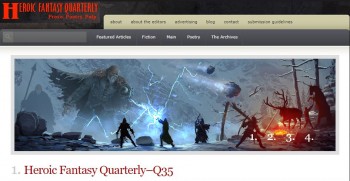 It was one of those months. By which I mean one where there were a lot of of new swords & sorcery stories. In addition to the regular two monthly stories from Swords and Sorcery Magazine, there were new issues of Cirsova and Heroic Fantasy Quarterly. Then, on top of all that, last Monday, what arrived at my door but the long waited-for first edition of the Howard Andrew Jones-edited and Appendix N-inspired Tales from the Magician’s Skull. Because there’s so much, I’m going to review HFQ and Tales this week and Cirsova and S&SM next week.
It was one of those months. By which I mean one where there were a lot of of new swords & sorcery stories. In addition to the regular two monthly stories from Swords and Sorcery Magazine, there were new issues of Cirsova and Heroic Fantasy Quarterly. Then, on top of all that, last Monday, what arrived at my door but the long waited-for first edition of the Howard Andrew Jones-edited and Appendix N-inspired Tales from the Magician’s Skull. Because there’s so much, I’m going to review HFQ and Tales this week and Cirsova and S&SM next week.
I don’t have much to say about Heroic Fantasy Quarterly (edited by Adrian Simmons and company) that I haven’t said time, and time again. It remains the best and most consistent source of new swords & sorcery fiction. If you aren’t reading it already, you are doing yourself a tremendous disservice. Issue #35, with magnificent banner art by Jereme Peabody, is no exception.
All right, I’m biased, but Raphael Ordoñez is one of my favorite writers working today, and I loved his new story, “White Rainbow and Brown Devil” in Issue #35. Not only is it a new story of “vagabond conquistador Francisco Carvajal y Lopez,” it’s got another of Ordoñez’s wonderful illustrations. In this tale of magic and danger, Francisco remains the same self-pitying, greedy but ultimately brave, hero he was introduced as in the first of his tales, “Heart of Tashyas.” He ended that tale in search of gold. This story opens with him frustrated and angry:
“Still no sign of them,” he growled, fingering the fishbone beads at his belt. “O Most Sweet Virgin, am I the victim of damnable perfidy yet again? With childlike trust have I followed Dacate’s word, seeking a modest recompense for all my sufferings in the painted canyons of the west. How many days has it been since I set out from the land of the Guequisales? Four? Five?” He raised the brown maul of his fist to heaven and shook it. “And where are these accursed canyons?”
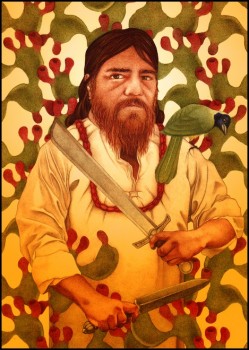 Spurred on by the hope of riches, Francisco offers to help a tribe being harried by devilish coyote-men. When the coyote-men carry off the tribe’s wise woman, Maikok Pepok, Francisco allows himself to be drawn into darker and stranger undertakings. Ordoñez’s cranky hero is one of the more memorable creations in recent S&S.
Spurred on by the hope of riches, Francisco offers to help a tribe being harried by devilish coyote-men. When the coyote-men carry off the tribe’s wise woman, Maikok Pepok, Francisco allows himself to be drawn into darker and stranger undertakings. Ordoñez’s cranky hero is one of the more memorable creations in recent S&S.
I liked “That Sleep of Death” by Mary-Jean Harris, but it is not S&S. Edwin Galbraith and his companion, Louis Earnshaw, are Victorian-era investigators of the paranormal. They are hired by Lady Wickham to dissuade her son from remaining a member of a possible cult. There’s astral travelling, mind-blowing displays of psychic powers, and a demon (maybe). It’s good fun, written with flair, but it’s not S&S, dagnabbit, and I admit to feeling a little let down.
The concluding story, “Things of Shreds and Patches” by Norman Doege, is more like it. The Lord-Apparent of Bremland and his whole realm are in danger, so he sends for his disgraced friend and oath-sworn brother, Kervan. I loved this, particularly the contrast between the courier Scori and Kervan. The royal messenger insists on doing everything he’s been tasked with to the best of his abilities and with all proper decorum. He is respectful of Kervan’s previous status, while the latter is now working as the bouncer in a low-class brothel. For Kervan, a man who’s given up the rough pleasures of his homeland for the benefits of literacy, forks, and soft bedding, the act is hogwash.
“I see my lord has an infallible arm, a mighty weapon,” Scori said, attempting to hide his appraisal of Kervan’s common gear. “May I ask its name?” A disdainful sneer crossed Kervan’s face.
“It’s an axe,” Kervan responded.
“My lord is too modest. Every noble weapon has a history! For instance, the Blade of Bremland, borne by the Bremish dukes since its forging by the first duke himself, Casimir the Founder, who used it to lay waste to the ice barbarians and carve Bremland from the northern cold, is an example of such a story. He used the weapon to sunder the very anvil upon which it was forged!”
Scori paused, waiting for Kervan to share. The hillman remembered the blade, a hand-and-a-halfer, dangling from old Duke Alset’s waist. Polished iron with an enormous chunk of amber inset in the pommel, the sword impressed the young Kervan. As a man, Kervan had seen such storied blades in the field and their edges held no better than any other’s. They made for fine bounty, though. Only fools named their weapons. If his axe had a story, Kervan knew it was lost on him. He never cared. His one-eyed grandfather claimed elves forged the head with a spirit of fire. The haft was a root from the world tree itself, the old man claimed. The runes adorning the steel probably told the tale, but no one Kervan knew could read them.
“It’s an axe,” Kervan said. “It splits wood and kills people.”
With that, Kervan threw his leg over his waiting horse and began a slow walk out of town. Disappointed, Scori followed suit.
Kervan’s return to his homeland, a place from which he’s been banished, is fraught with perils and intrigue. In this tale of a dead lord, his discomposed son, and a dangerous uncle, there’s a whiff of Hamlet — if Horatio knew how to swing an axe.
There are, as usual, poems. In the first, James Matthew Byers’ “The Washer at the Ford,” the war goddess, Badb, metes out her harsh favors on soldiers in battle. “Dragon Mountain” by Mary Soon Lee is another installment in her ongoing epic, Sign of the Dragon Cycle. In this part, King Xau and Captain Li receive a summons that brings them face to face with a dragon. Dragons also figure strongly in Karen Bovenmyer’s “Fire Love.” It’s a poem of love, battle, and — dragons. Bovenmyer also provides a recitation of the poem that’s quite good.
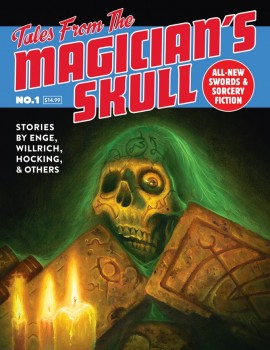 Now, we come to Tales from the Magician’s Skull, No.1. Edited by sword & sorcery author and Black Gate alum Howard Andrew Jones, and published by Joseph Goodman of Goodman Games, this extravagantly illustrated slab of sword-swinging, wand-waving, monster-cleaving tale-telling is exactly what I want in a S&S collection.
Now, we come to Tales from the Magician’s Skull, No.1. Edited by sword & sorcery author and Black Gate alum Howard Andrew Jones, and published by Joseph Goodman of Goodman Games, this extravagantly illustrated slab of sword-swinging, wand-waving, monster-cleaving tale-telling is exactly what I want in a S&S collection.
In an introduction from the titular skull, the magazine’s intentions are made perfectly clear at the outset.
HEAR this, mortal dogs. You hold in your hands a magazine the likes of which has not been seen for many suns. Once there were magicians whose weird tales could change the wormy earth. They infiltrated your waking world, bringing wonder and glory and imagination. Fantastic visions you dogs could barely grasp. But mortals they were, all of them. They’re dust now. With their passing a Thing was gone, a Secret passed. Well, no more. Magicians of the word, the weird tale-tellers: they may be gone, but their vision lives on. I am the skull and soul of one such word-wizard, and I’ll bring you Secrets that haven’t walked the earth in this century. Stories they’ll be, stories that make you bolt up and hunger for adventure. You’ll remember what glory could be, you’ll realize how you worms have lost sight of the sun.
I am the Magician’s Skull. Which magician? One you’ve never heard of: a peer of Howard and Lovecraft, Burroughs and Derleth, Dunsany and Leiber. A wizard who knew Merritt and St. Clair and Vance and Brackett and Wellman and Weinbaum, and Clark Ashton Smith and even grand Gygax himself. All the word-wizards wove wonder, and it matters not whose bones I rot with today. All you need to know is: I bring tales of great fantasy and wondrous adventure. Get ready, mortal dogs. Enjoy this first issue. Enjoy the adventure!
That’s a bold statement and a challenge to any reasonably deep reader of S&S. I’m excited to report Jones and Goodman have been successful. They did stack the deck a bit by including several authors I like a lot: James Enge, Bill Ward, and Jones himself. Of course it makes perfect sense for any new compilation to feature writers who were part of the outburst of great new S&S that started about a decade ago.
“What Lies in Ice” by Chris Willrich kicks off the issue with a slime- and weirdness-soaked story of the hunt for a wizard’s tower. It stars his ongoing characters (whom I haven’t the slightest idea how I’ve missed until now), the thieving couple, Persimmon Gaunt and Imago Bone. They were rescued by the Sea-Glare and its captain, Dawnglass, in the aftermath of some unspeakable caper. Knowing them and their reputations, Dawnglass saw their arrival as a good omen for his quest. Perhaps, but their presence doesn’t prevent the ship from coming under assault as it nears its goal.
It began again. In the moonlight hundreds of once-human hands, wrinkled and barnacled and stinking of ocean slime, rose from the waters and clawed blindly at the hull. They covered the painted eyes that glowered at Sea-Glare’s prow, scuttled toward the oar-ports, and crawled up the rudder.
And among the death-grey hands were the paws of white bears and the claws of orange crabs, and here and there the rosy blooms of sea anemones, and the pink tentacles of squid, and many another thing that once grasped and tore beneath the waves. The mass of manipulators rose as one scuffling, clutching horde. Their swarming was even more unnatural than it first appeared, for if they lost their grip they dangled for a while mid-air like puppets on unseen strings, before grasping Sea-Glare once more. A maddening chorus of scratching and clawing echoed throughout the ship, amid the wash of waters, the creaks of wood, and the shouts of men.
The Hands of the Sea dragged one rower screaming into the night, rending him to red fragments.
Once at the iceberg-encased tower, things get decidely worse for Gaunt, Bone, and the Sea-Glare‘s crew. They are split up from each other and must face the tower’s dangers on their own. In this story packed with magic and mayhem, Willrich paints the characters with enough depth to make them stand out from one another as well as to make the reader actually worry they might not make it through to the end.
James Enge’s “The Guild of Silent Men” is a tale of magical ratiocination, prejudice, and betrayal from early in the career of Morlock Ambrosius. The crooked-backed hero of six books and many short stories, here Morlock is young and still learning his way. He is approached by the Guild of Silent Men to investigate the murders of two of its members. The Guild serves a special purpose in Morlock’s world:
Some men and women had no kin who would acknowledge them; they had no professional guild or club that would admit them. These joined the Guild of Silent Men or the League of Silent Women, finding strength and help among the other friendless and helpless.
Taciturn, irascible, and more honorable than those he serves, Morlock continues to be one my favorite S&S protagonists. Anything else I write about the plot would only subtract from the enjoyment that should be had reading it. Now I need to be a better fan and catch up on the last three books I’ve let sit rotting on my Kindle.
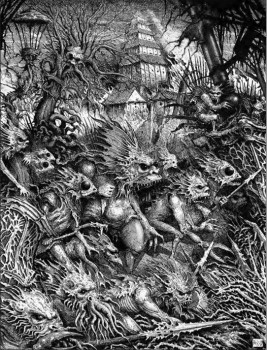 In “Beneath the Bay of Black Waters” Bill Ward’s heroes, Imperial investigator Commissioner Shan and his associate, General Bao, must seek out the source of the vile drug Black Pearl in the city of Long-He. When we join them, they are leading an assault on the drug’s primary distributor, the Fish-Gutter Gang. Knowledge extracted from a prisoner leads Shan and Bao on a hunt that takes them out into the bay to catch the drug’s suppliers. When the suppliers arrive the story becomes a non-stop blast of magical underwater mayhem. It also has an amazing illustration by Ian Miller, one of my favorite S&S artists.
In “Beneath the Bay of Black Waters” Bill Ward’s heroes, Imperial investigator Commissioner Shan and his associate, General Bao, must seek out the source of the vile drug Black Pearl in the city of Long-He. When we join them, they are leading an assault on the drug’s primary distributor, the Fish-Gutter Gang. Knowledge extracted from a prisoner leads Shan and Bao on a hunt that takes them out into the bay to catch the drug’s suppliers. When the suppliers arrive the story becomes a non-stop blast of magical underwater mayhem. It also has an amazing illustration by Ian Miller, one of my favorite S&S artists.
“Beyond the Block” by Aeryn Rudel is a short, nasty piece of work narrated by Matthias, a man condemned for trying to rescue his sister from the sorceror, the Lord Magister Gregor Vyard. If the honking obvious illustration at the story’s beginning didn’t give away the game, I’d say this is another story whose secrets should be preserved for the readers. I still won’t say much, but the block in the title refers to the headsman’s block. Though it lacks the verbal opulence of a Clark Ashton Smith story, Rudel’s rings of a similar, let’s say, pitch-black humor.
In Howard Andrew Jones’ “Crypt of Stars,” soldiers of the mighty Dervan Empire are searching for the funerary treasures of the great families of the recently conquered city of Volanus. Helping them as they scour a cemetery island for the richest pickings is Indar, the son of a Volani family loyal to the new Dervani order. Unknown to him and his new masters, the great Volani hero, Hanuvar Cabera, assumed dead, is preparing a terrible surprise for them.
There are several things going on in Jones’ story involving monsters, murder, and misdirection. At its heart, though, there’s a serious question: collaboration and survival or defiance and destruction? That’s a heady thing, but considering Hanuvar Cabera is a fantasy take on Hannibal Barca, I think it’s clear on which side Jones comes down.
“There Was an Old Fat Spider” by C.L. Werner is another dose of monsters and murder. This time the murder weapon is the creature of the title, but the real murderer is almost universally disliked Karl Rohlfs. When he discovers the spider, clearly old and weak, deep in the Baron’s woods, he comes up with a plan. With a story of hidden wealth, Karl lures his enemies to their deaths and the spider’s gullet.
Werner’s protrayal of the despicable Karl is pitch-perfect. When he first meets the spider and commits an awful deed he is ashamed of himself. In a fit of self-pity that becomes fear, he fixes on the hatred in his heart for everyone who has ever done him wrong. It’s in that moment he wills himself to become a murderer.
The concluding story is John C. Hocking’s “The Crystal Sickle’s Harvest.” There’s not much to the plot: two men in royal service come to a graveyard in search of the graverobbers who’ve been despoiling tombs of the nobility. The tale’s success lies in the darkly atmospheric setting and the personalities of its two main characters, Thratos and Benhus.
Thratos, sometimes called the King’s Hand, is deeply learned and the owner of several magic wands. Given by the King to his favorites, they are called a Nobleman’s Comfort. Some project beams of coherent light while others shoot out rays that instantly age and kill whatever they hit. He is also relentlessly contemptuous of his young assistant, Benhus, something which will have tremendous consequences.
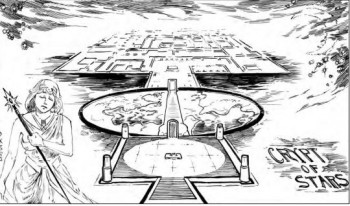 Did I say Tales from the Magician’s Skull is lavishly illustrated? Because it is. Each story gets its own picture. Most also get an illustrated RPG-style map of its major dungeon. Just in case you forgot, Goodman Games’ primary business is the Dungeon Crawl Classics RPG. There are game stats for all the stories’ monsters and spells in the back of the issue.
Did I say Tales from the Magician’s Skull is lavishly illustrated? Because it is. Each story gets its own picture. Most also get an illustrated RPG-style map of its major dungeon. Just in case you forgot, Goodman Games’ primary business is the Dungeon Crawl Classics RPG. There are game stats for all the stories’ monsters and spells in the back of the issue.
Jones is one of the most knowledgable writers on the subject of swords & sorcery, and that is clearly at work in Tales. Too many things passed off as S&S today are not. That doesn’t happen here.
At $14.99, Tales from the Magician’s Skull is worth it. You can get it through Goodman Games’ site. The second issue is already in the hopper and looks like it will be available by this summer. In an age of big series and big books, I’m excited to have a new publication focusing on real S&S. Based on this issue, I have high hopes for Tales‘ future.
A lot of words today, but merited. HFQ and Tales are doing the work that needs to be done if real S&S is to thrive in this day and age. Both are edited by men who know the history of the genre and how it’s written. They both have a feeling for actual heroes, or at least brave and bold rogues. Instead of often dull faux-realism, they look for wonder and the fantastic in fiction. Right now, they are finding and publishing the fiction I want to read, and I suspect many of you do as well.
NOTE: I forgot to read the bonus Howard Andrew Jones story that came in the Kickstarter package. Next week, folks!
Fletcher Vredenburgh reviews here at Black Gate most Tuesday mornings and at his own site, Stuff I Like when his muse hits him. Right now, he’s writing about scary stuff, but he might be writing about swords & sorcery again any day now.
I’ve been on a massive Morlock kick lately. Guild of Silent Men is the only story I’ve read so far and I loved it.
Wide Worlds End has been sitting on muni shelf since it came out. Started it last week and finished it last night. Best in the trilogy.
James has released several short story ebooks that compile a number of the Morlock stories that have been published elsewhere. The one titled Wintry Mix has been my favorite so far.
I’m hoping to have to time to read the Werner story tonight. I thought his Mu-Thulan stories were great.
@Glenn – I’ve never found a Morlock story I don’t like. I keep meaning to check those story compilations to make sure there’s nothing I’ve missed.
As far as I can tell. The collection titled Ambrosaii: Three Stories has a one called “Broken Mirror” that hasn’t appeared anywhere else.
But a couple were only released on Pyr website and I’m not even sure they are there anymore.
It’s worth it to have them all collected in one spot. Now if James would just do a printed collection of them.
Thanks for another great review! Raphael Ordonez should be a rising star in this sub genre and HFQ is doing what we can to make this happen.
“That Sleep of Death” was a bit of an outlier for us, and somewhat refreshing for that.
“Things of Shreds and Patches” brought it all back to S&S, though!
Glad that you liked the poetry, too. I’m hoping we can get Karen Bovenmyer to do more audio work for us.
Thanks for the kind words, you guys. Glenn is right that “Broken Mirror” is the only Morlock story in those ebooks that hadn’t seen light somewhere else–and it’s really more of an Ambrosia story.
I’ve thought a lot about a real collection of Morlock stories, but the set doesn’t seem complete yet. There are a couple more stories due out this year, for instance, and a couple more that seem to want to be written.
@Adrian – Keep the good stuff coming! Yep, Raphael’s very good. One of the writers most attuned to keeping the spirit of pre-genrefied fantasy alive.
@James E. – You’re welcome. Thanks for the clarification.
[…] and in case you missed it, the first big review of Tales From the Magician’s Skull has appeared, and good things were […]